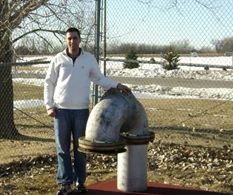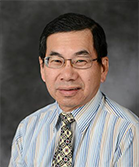CFD Modeling of Unsteady Flow in Ground Water Storage Tanks to Evaluate Chlorine Decay for Various Flow Path Configurations

Derrick Deering is a Master of Engineering student in Civil Engineering with an emphasis in Water Resources Engineering at the University of North Dakota. In the fall of 2012 he graduated with a Bachelor of Science degree in Civil Engineering at the University of North Dakota. His research focuses on chlorine decay in a water storage tank in East Grand Forks, North Dakota utilizing Computational Fluid Dynamics (CFD) software.
Email: derrick.deering@my.und.edu
Phone: (320) 309-2650
Fellow: Derrick Deering
Advisor: Yeo Howe Lim, Ph.D., Associate Professor, Department of Civil Engineering, University of North Dakota.
Degree Progress: M.S. in Civil Engineering with an emphasis in Water Resources Engineering, expected graduation in summer 2014.
CFD Modeling of Unsteady Flow in Ground Water Storage Tanks to Evaluate Chlorine Decay for Various Flow Path Configurations
Storage tanks are designed to supply water demand as well as provide storage for fire-fighting. Generally, when operating under normal conditions a fraction of the water within the tank is utilized. Since chlorine decay occurs in relation with time, a combination of extended water age and unmixed tank conditions generates varying water quality throughout the tank. Previous literature documents water entering the storage tank with sufficient concentration and exiting with a chlorine concentration that is extremely low. When chlorine concentration is extremely low the possibility of bacterial growth increases impacting human health.
East Grand Forks, MN has experienced chlorine depletion in a particular storage tank in the past. To resolve the issue a tank mixer was installed to achieve completely mixed conditions. However, it is believed that if hydraulic conditions are taken into account during the design process, completely mixed conditions with higher water quality throughout may be efficiently achieved.
Project Objectives:
The main objective of this research is to create an accurate three-dimensional, multiphase, free surface, CFD model, utilizing ANYSYS CFX software. Specific objectives are as follows:
- Gather temperature data of the reservoir to create an accurate representation of the reservoir in East Grand Forks, MN
- Incorporate temperatures of the water within the reservoir and its immediate surrounding environment into the CFD model
- Analyze the current flow dynamics of the reservoir
- Modify the interior geometry to increase the through velocity
- Compare and contrast the different options the city has and propose the most efficient method to the city of East Grand Forks
- Expand the application of CFD modeling in hydraulic engineering
Progress:
Water temperature and chlorine concentration have been measured within the storage tank from January through April 2013. Soil temperatures were collected from North Dakota State Climate Office. CFD models have been created and initial conditions have been set. Currently, model computations are underway for the actual geometry of the tank in East Grand Forks as well as an alternative tank to geometry. Potential flow conditions for each geometry are considered and modeled separately. Based on completed outcomes, modeling three-dimensional, multi-phase, free-surface flow has been accomplished.
Significance:
Generally, water quality has been analyzed under the assumption that storage tanks are completely mixed. However, previous literature indicates otherwise based on field test. With the advancement of technology CFD software has begun to be implemented into the field of hydraulics. Previously, CFD analysis of storage tanks were modeled as steady state because of the extensive computation time and memory. This research considers unsteady flow conditions with fluctuating water levels as well as temperature interactions during the winter season.
Conference/Seminar Presentations:
Deering, D. and Lim, Y.H. (2012). “Efficient Energy Use in Pump Water Supply Systems in Cold Regions.” Proc., Environmental and Water Resources Institute, ASCE, Albuquerque, NM, 3044-3053. (Oral presentation and proceeding paper)
Deering, D. and Lim, Y.H. (2013). “Operating Small Pump Water Supply Systems Efficiently in Cold Regions.” Proc., International Symposium on Cold Regions Development, ASCE, Anchorage, AK., 791-801. (Oral presentation and proceeding paper)
Deering D. and Lim, Y.H. (2014) “Identification of Safe Navigation Routes in a Remote Watershed under Extreme Storm Events Utilizing GIS and Hydrologic Models.” Proc., Environmental and Water Resources Institute, ASCE, Portland, OR, June 2014. (Poster and proceeding paper)

Lim Yeo Howe
Civil Engineering
Upson Hall II Room 260D
243 Centennial Drive Stop 8115
Grand Forks, ND 58202-8115
Phone: 701-777-3998
Email: yeo.lim@und.edu


